Next Plc: Evaluating International Market Entry and Marketing Mix
VerifiedAdded on 2019/12/03
|14
|3959
|152
Report
AI Summary
This report analyzes the international marketing strategies for Next Plc, a British multinational clothing retailer, focusing on expanding its business into international markets, specifically Brazil and Australia. It begins with an overview of international marketing and then examines the macro and micro factors impacting retail markets using PESTLE and SWOT analyses. The report evaluates market potential, recommending Brazil and Australia due to their growth potential and consumer behavior. It explores various market entry strategies like licensing, direct exporting, franchising, and joint ventures, recommending licensing for Brazil and franchising for Australia. Finally, the report suggests adaptations to the marketing mix, considering product, price, promotion, and place, to cater to the specific consumer preferences and market conditions in each country. The analysis considers the value chain and Porter's five forces to provide a comprehensive strategy for Next Plc's international expansion.
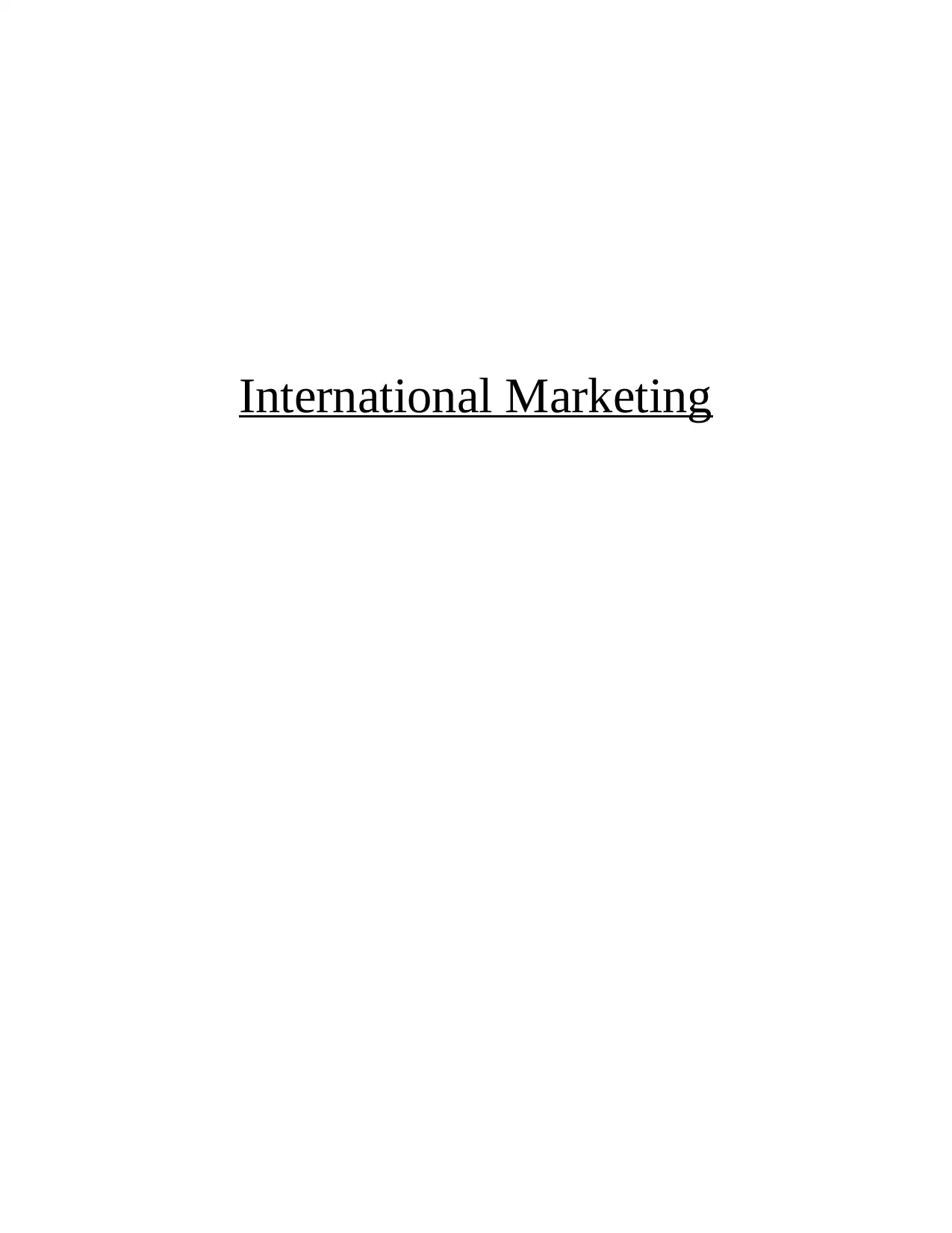
International Marketing
Paraphrase This Document
Need a fresh take? Get an instant paraphrase of this document with our AI Paraphraser
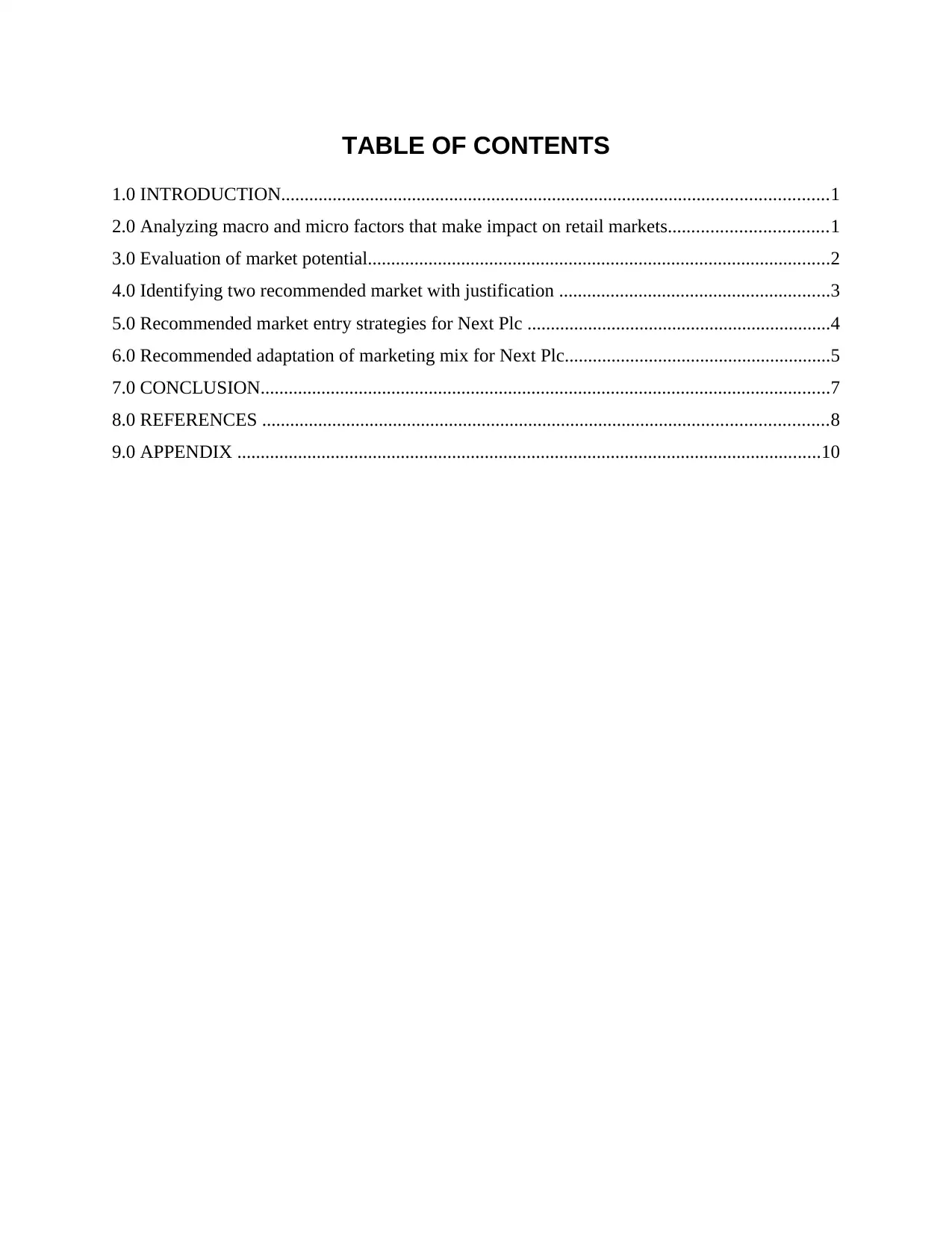
TABLE OF CONTENTS
1.0 INTRODUCTION.....................................................................................................................1
2.0 Analyzing macro and micro factors that make impact on retail markets..................................1
3.0 Evaluation of market potential...................................................................................................2
4.0 Identifying two recommended market with justification ..........................................................3
5.0 Recommended market entry strategies for Next Plc .................................................................4
6.0 Recommended adaptation of marketing mix for Next Plc.........................................................5
7.0 CONCLUSION..........................................................................................................................7
8.0 REFERENCES .........................................................................................................................8
9.0 APPENDIX .............................................................................................................................10
1.0 INTRODUCTION.....................................................................................................................1
2.0 Analyzing macro and micro factors that make impact on retail markets..................................1
3.0 Evaluation of market potential...................................................................................................2
4.0 Identifying two recommended market with justification ..........................................................3
5.0 Recommended market entry strategies for Next Plc .................................................................4
6.0 Recommended adaptation of marketing mix for Next Plc.........................................................5
7.0 CONCLUSION..........................................................................................................................7
8.0 REFERENCES .........................................................................................................................8
9.0 APPENDIX .............................................................................................................................10
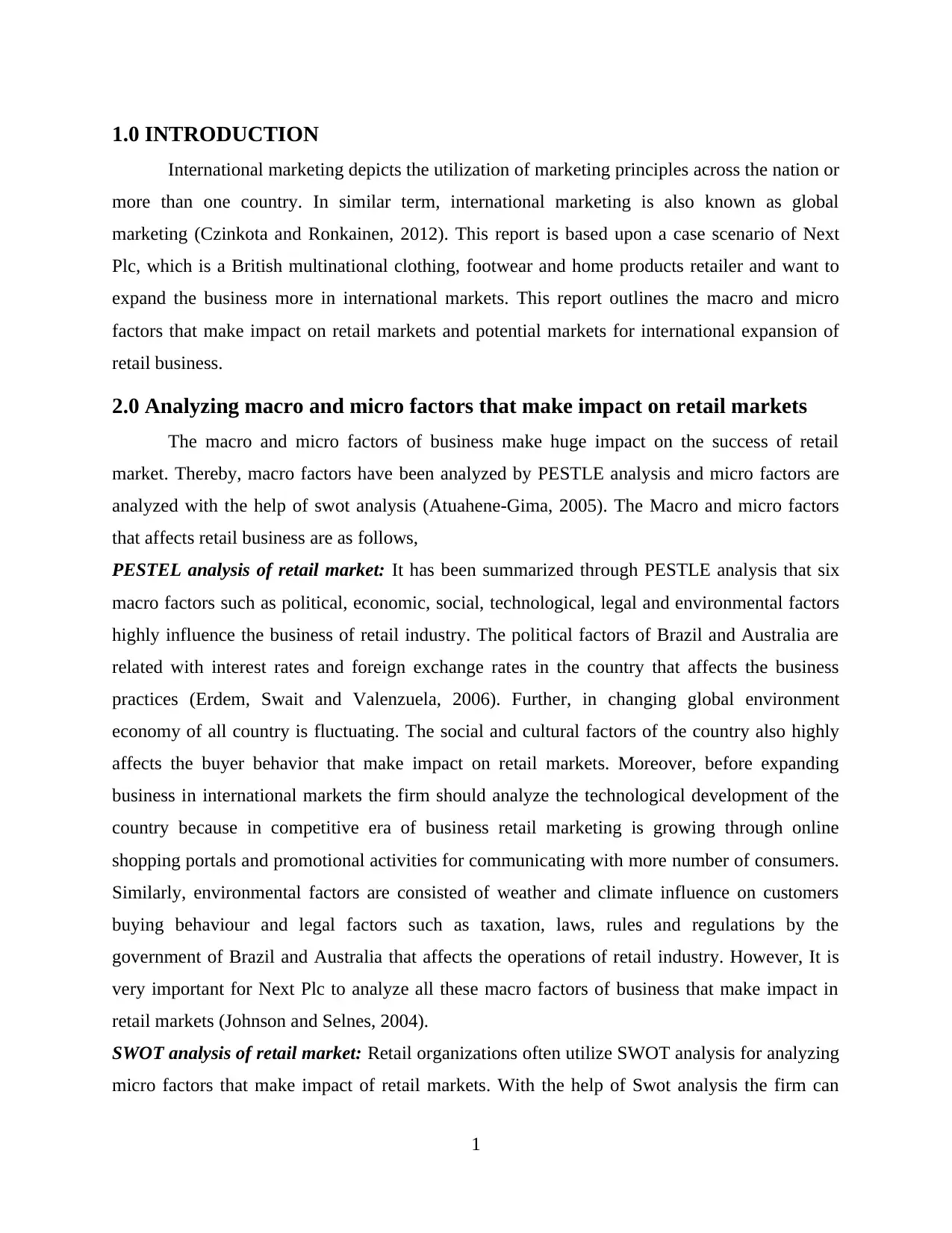
1.0 INTRODUCTION
International marketing depicts the utilization of marketing principles across the nation or
more than one country. In similar term, international marketing is also known as global
marketing (Czinkota and Ronkainen, 2012). This report is based upon a case scenario of Next
Plc, which is a British multinational clothing, footwear and home products retailer and want to
expand the business more in international markets. This report outlines the macro and micro
factors that make impact on retail markets and potential markets for international expansion of
retail business.
2.0 Analyzing macro and micro factors that make impact on retail markets
The macro and micro factors of business make huge impact on the success of retail
market. Thereby, macro factors have been analyzed by PESTLE analysis and micro factors are
analyzed with the help of swot analysis (Atuahene-Gima, 2005). The Macro and micro factors
that affects retail business are as follows,
PESTEL analysis of retail market: It has been summarized through PESTLE analysis that six
macro factors such as political, economic, social, technological, legal and environmental factors
highly influence the business of retail industry. The political factors of Brazil and Australia are
related with interest rates and foreign exchange rates in the country that affects the business
practices (Erdem, Swait and Valenzuela, 2006). Further, in changing global environment
economy of all country is fluctuating. The social and cultural factors of the country also highly
affects the buyer behavior that make impact on retail markets. Moreover, before expanding
business in international markets the firm should analyze the technological development of the
country because in competitive era of business retail marketing is growing through online
shopping portals and promotional activities for communicating with more number of consumers.
Similarly, environmental factors are consisted of weather and climate influence on customers
buying behaviour and legal factors such as taxation, laws, rules and regulations by the
government of Brazil and Australia that affects the operations of retail industry. However, It is
very important for Next Plc to analyze all these macro factors of business that make impact in
retail markets (Johnson and Selnes, 2004).
SWOT analysis of retail market: Retail organizations often utilize SWOT analysis for analyzing
micro factors that make impact of retail markets. With the help of Swot analysis the firm can
1
International marketing depicts the utilization of marketing principles across the nation or
more than one country. In similar term, international marketing is also known as global
marketing (Czinkota and Ronkainen, 2012). This report is based upon a case scenario of Next
Plc, which is a British multinational clothing, footwear and home products retailer and want to
expand the business more in international markets. This report outlines the macro and micro
factors that make impact on retail markets and potential markets for international expansion of
retail business.
2.0 Analyzing macro and micro factors that make impact on retail markets
The macro and micro factors of business make huge impact on the success of retail
market. Thereby, macro factors have been analyzed by PESTLE analysis and micro factors are
analyzed with the help of swot analysis (Atuahene-Gima, 2005). The Macro and micro factors
that affects retail business are as follows,
PESTEL analysis of retail market: It has been summarized through PESTLE analysis that six
macro factors such as political, economic, social, technological, legal and environmental factors
highly influence the business of retail industry. The political factors of Brazil and Australia are
related with interest rates and foreign exchange rates in the country that affects the business
practices (Erdem, Swait and Valenzuela, 2006). Further, in changing global environment
economy of all country is fluctuating. The social and cultural factors of the country also highly
affects the buyer behavior that make impact on retail markets. Moreover, before expanding
business in international markets the firm should analyze the technological development of the
country because in competitive era of business retail marketing is growing through online
shopping portals and promotional activities for communicating with more number of consumers.
Similarly, environmental factors are consisted of weather and climate influence on customers
buying behaviour and legal factors such as taxation, laws, rules and regulations by the
government of Brazil and Australia that affects the operations of retail industry. However, It is
very important for Next Plc to analyze all these macro factors of business that make impact in
retail markets (Johnson and Selnes, 2004).
SWOT analysis of retail market: Retail organizations often utilize SWOT analysis for analyzing
micro factors that make impact of retail markets. With the help of Swot analysis the firm can
1
⊘ This is a preview!⊘
Do you want full access?
Subscribe today to unlock all pages.

Trusted by 1+ million students worldwide
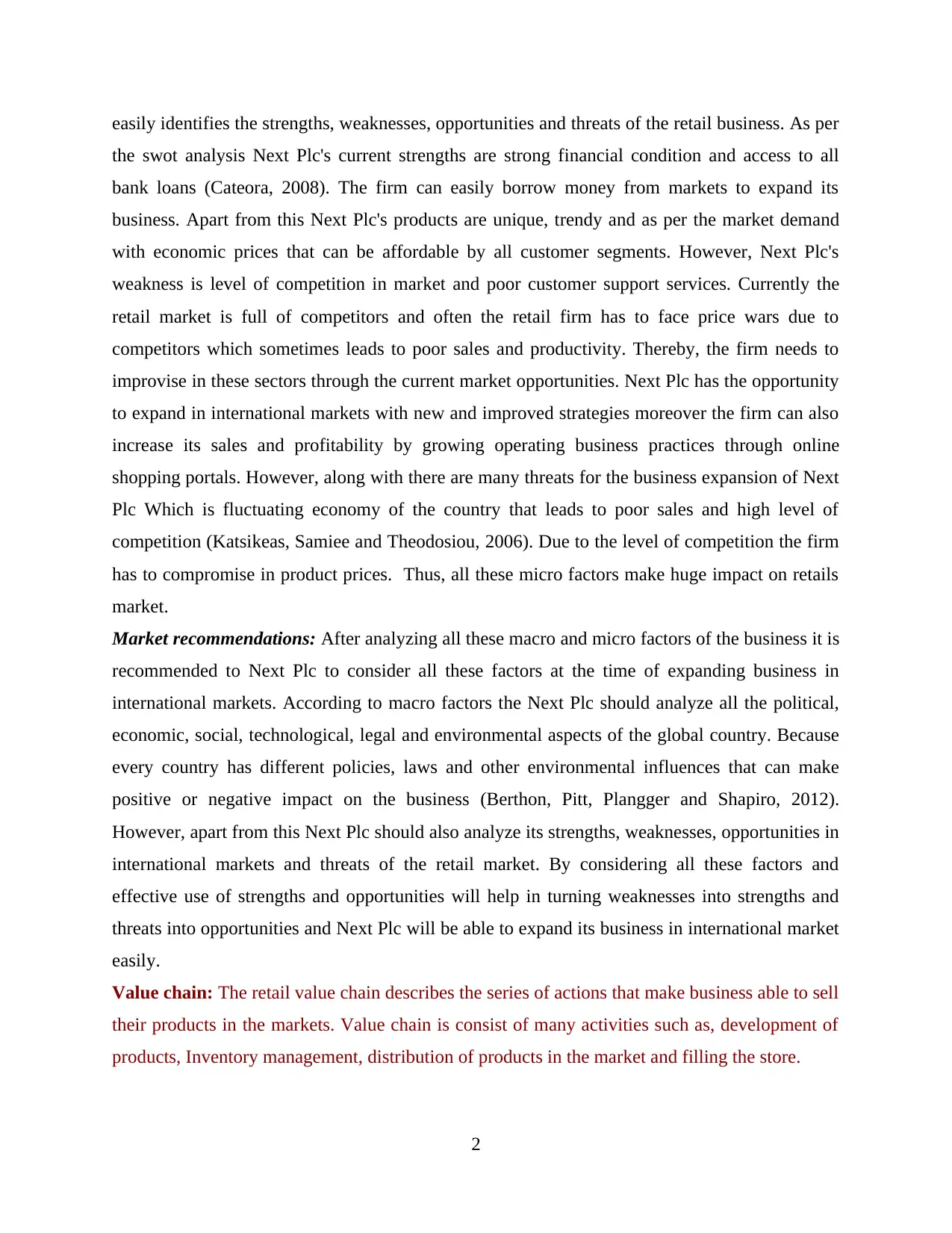
easily identifies the strengths, weaknesses, opportunities and threats of the retail business. As per
the swot analysis Next Plc's current strengths are strong financial condition and access to all
bank loans (Cateora, 2008). The firm can easily borrow money from markets to expand its
business. Apart from this Next Plc's products are unique, trendy and as per the market demand
with economic prices that can be affordable by all customer segments. However, Next Plc's
weakness is level of competition in market and poor customer support services. Currently the
retail market is full of competitors and often the retail firm has to face price wars due to
competitors which sometimes leads to poor sales and productivity. Thereby, the firm needs to
improvise in these sectors through the current market opportunities. Next Plc has the opportunity
to expand in international markets with new and improved strategies moreover the firm can also
increase its sales and profitability by growing operating business practices through online
shopping portals. However, along with there are many threats for the business expansion of Next
Plc Which is fluctuating economy of the country that leads to poor sales and high level of
competition (Katsikeas, Samiee and Theodosiou, 2006). Due to the level of competition the firm
has to compromise in product prices. Thus, all these micro factors make huge impact on retails
market.
Market recommendations: After analyzing all these macro and micro factors of the business it is
recommended to Next Plc to consider all these factors at the time of expanding business in
international markets. According to macro factors the Next Plc should analyze all the political,
economic, social, technological, legal and environmental aspects of the global country. Because
every country has different policies, laws and other environmental influences that can make
positive or negative impact on the business (Berthon, Pitt, Plangger and Shapiro, 2012).
However, apart from this Next Plc should also analyze its strengths, weaknesses, opportunities in
international markets and threats of the retail market. By considering all these factors and
effective use of strengths and opportunities will help in turning weaknesses into strengths and
threats into opportunities and Next Plc will be able to expand its business in international market
easily.
Value chain: The retail value chain describes the series of actions that make business able to sell
their products in the markets. Value chain is consist of many activities such as, development of
products, Inventory management, distribution of products in the market and filling the store.
2
the swot analysis Next Plc's current strengths are strong financial condition and access to all
bank loans (Cateora, 2008). The firm can easily borrow money from markets to expand its
business. Apart from this Next Plc's products are unique, trendy and as per the market demand
with economic prices that can be affordable by all customer segments. However, Next Plc's
weakness is level of competition in market and poor customer support services. Currently the
retail market is full of competitors and often the retail firm has to face price wars due to
competitors which sometimes leads to poor sales and productivity. Thereby, the firm needs to
improvise in these sectors through the current market opportunities. Next Plc has the opportunity
to expand in international markets with new and improved strategies moreover the firm can also
increase its sales and profitability by growing operating business practices through online
shopping portals. However, along with there are many threats for the business expansion of Next
Plc Which is fluctuating economy of the country that leads to poor sales and high level of
competition (Katsikeas, Samiee and Theodosiou, 2006). Due to the level of competition the firm
has to compromise in product prices. Thus, all these micro factors make huge impact on retails
market.
Market recommendations: After analyzing all these macro and micro factors of the business it is
recommended to Next Plc to consider all these factors at the time of expanding business in
international markets. According to macro factors the Next Plc should analyze all the political,
economic, social, technological, legal and environmental aspects of the global country. Because
every country has different policies, laws and other environmental influences that can make
positive or negative impact on the business (Berthon, Pitt, Plangger and Shapiro, 2012).
However, apart from this Next Plc should also analyze its strengths, weaknesses, opportunities in
international markets and threats of the retail market. By considering all these factors and
effective use of strengths and opportunities will help in turning weaknesses into strengths and
threats into opportunities and Next Plc will be able to expand its business in international market
easily.
Value chain: The retail value chain describes the series of actions that make business able to sell
their products in the markets. Value chain is consist of many activities such as, development of
products, Inventory management, distribution of products in the market and filling the store.
2
Paraphrase This Document
Need a fresh take? Get an instant paraphrase of this document with our AI Paraphraser
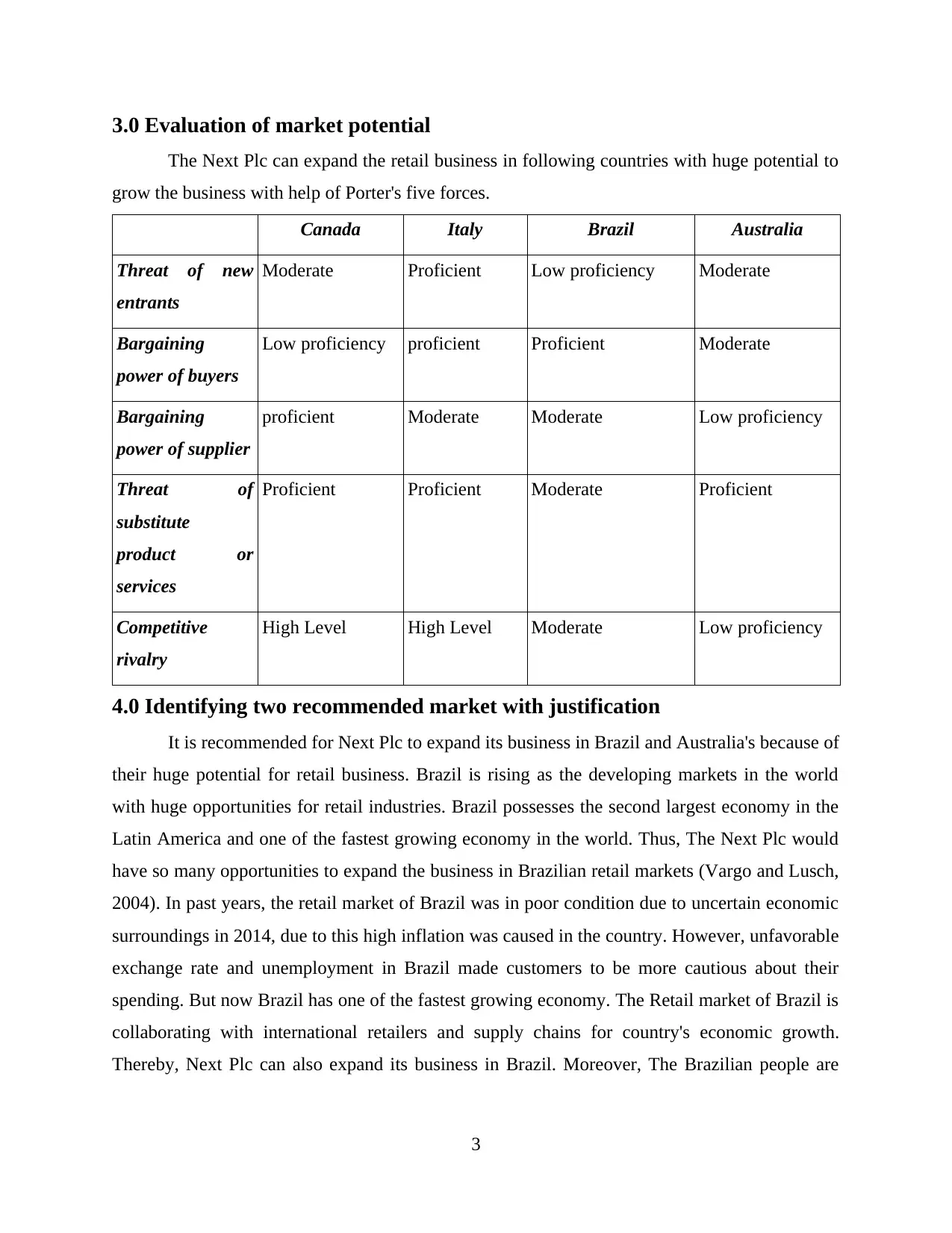
3.0 Evaluation of market potential
The Next Plc can expand the retail business in following countries with huge potential to
grow the business with help of Porter's five forces.
Canada Italy Brazil Australia
Threat of new
entrants
Moderate Proficient Low proficiency Moderate
Bargaining
power of buyers
Low proficiency proficient Proficient Moderate
Bargaining
power of supplier
proficient Moderate Moderate Low proficiency
Threat of
substitute
product or
services
Proficient Proficient Moderate Proficient
Competitive
rivalry
High Level High Level Moderate Low proficiency
4.0 Identifying two recommended market with justification
It is recommended for Next Plc to expand its business in Brazil and Australia's because of
their huge potential for retail business. Brazil is rising as the developing markets in the world
with huge opportunities for retail industries. Brazil possesses the second largest economy in the
Latin America and one of the fastest growing economy in the world. Thus, The Next Plc would
have so many opportunities to expand the business in Brazilian retail markets (Vargo and Lusch,
2004). In past years, the retail market of Brazil was in poor condition due to uncertain economic
surroundings in 2014, due to this high inflation was caused in the country. However, unfavorable
exchange rate and unemployment in Brazil made customers to be more cautious about their
spending. But now Brazil has one of the fastest growing economy. The Retail market of Brazil is
collaborating with international retailers and supply chains for country's economic growth.
Thereby, Next Plc can also expand its business in Brazil. Moreover, The Brazilian people are
3
The Next Plc can expand the retail business in following countries with huge potential to
grow the business with help of Porter's five forces.
Canada Italy Brazil Australia
Threat of new
entrants
Moderate Proficient Low proficiency Moderate
Bargaining
power of buyers
Low proficiency proficient Proficient Moderate
Bargaining
power of supplier
proficient Moderate Moderate Low proficiency
Threat of
substitute
product or
services
Proficient Proficient Moderate Proficient
Competitive
rivalry
High Level High Level Moderate Low proficiency
4.0 Identifying two recommended market with justification
It is recommended for Next Plc to expand its business in Brazil and Australia's because of
their huge potential for retail business. Brazil is rising as the developing markets in the world
with huge opportunities for retail industries. Brazil possesses the second largest economy in the
Latin America and one of the fastest growing economy in the world. Thus, The Next Plc would
have so many opportunities to expand the business in Brazilian retail markets (Vargo and Lusch,
2004). In past years, the retail market of Brazil was in poor condition due to uncertain economic
surroundings in 2014, due to this high inflation was caused in the country. However, unfavorable
exchange rate and unemployment in Brazil made customers to be more cautious about their
spending. But now Brazil has one of the fastest growing economy. The Retail market of Brazil is
collaborating with international retailers and supply chains for country's economic growth.
Thereby, Next Plc can also expand its business in Brazil. Moreover, The Brazilian people are
3
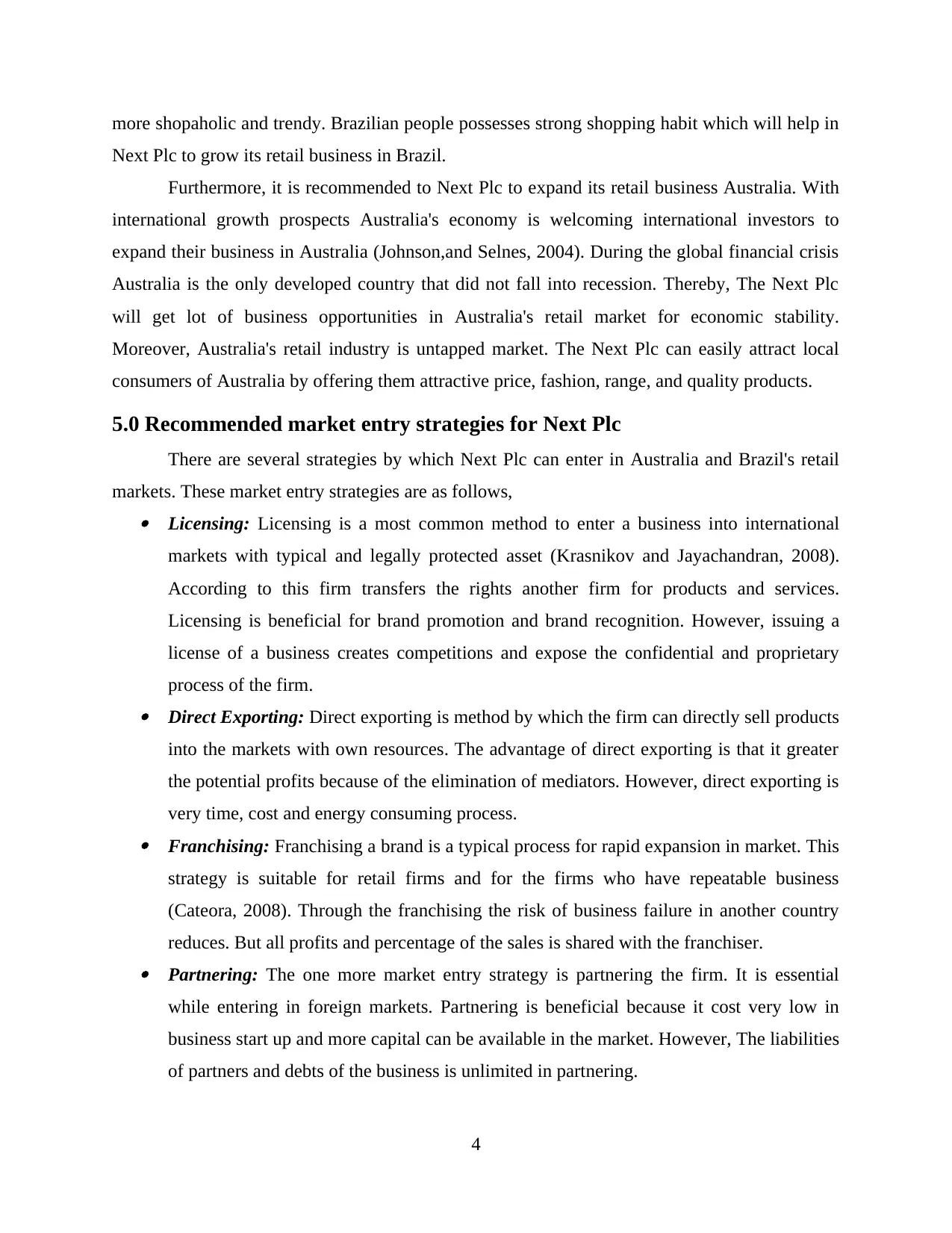
more shopaholic and trendy. Brazilian people possesses strong shopping habit which will help in
Next Plc to grow its retail business in Brazil.
Furthermore, it is recommended to Next Plc to expand its retail business Australia. With
international growth prospects Australia's economy is welcoming international investors to
expand their business in Australia (Johnson,and Selnes, 2004). During the global financial crisis
Australia is the only developed country that did not fall into recession. Thereby, The Next Plc
will get lot of business opportunities in Australia's retail market for economic stability.
Moreover, Australia's retail industry is untapped market. The Next Plc can easily attract local
consumers of Australia by offering them attractive price, fashion, range, and quality products.
5.0 Recommended market entry strategies for Next Plc
There are several strategies by which Next Plc can enter in Australia and Brazil's retail
markets. These market entry strategies are as follows, Licensing: Licensing is a most common method to enter a business into international
markets with typical and legally protected asset (Krasnikov and Jayachandran, 2008).
According to this firm transfers the rights another firm for products and services.
Licensing is beneficial for brand promotion and brand recognition. However, issuing a
license of a business creates competitions and expose the confidential and proprietary
process of the firm. Direct Exporting: Direct exporting is method by which the firm can directly sell products
into the markets with own resources. The advantage of direct exporting is that it greater
the potential profits because of the elimination of mediators. However, direct exporting is
very time, cost and energy consuming process. Franchising: Franchising a brand is a typical process for rapid expansion in market. This
strategy is suitable for retail firms and for the firms who have repeatable business
(Cateora, 2008). Through the franchising the risk of business failure in another country
reduces. But all profits and percentage of the sales is shared with the franchiser. Partnering: The one more market entry strategy is partnering the firm. It is essential
while entering in foreign markets. Partnering is beneficial because it cost very low in
business start up and more capital can be available in the market. However, The liabilities
of partners and debts of the business is unlimited in partnering.
4
Next Plc to grow its retail business in Brazil.
Furthermore, it is recommended to Next Plc to expand its retail business Australia. With
international growth prospects Australia's economy is welcoming international investors to
expand their business in Australia (Johnson,and Selnes, 2004). During the global financial crisis
Australia is the only developed country that did not fall into recession. Thereby, The Next Plc
will get lot of business opportunities in Australia's retail market for economic stability.
Moreover, Australia's retail industry is untapped market. The Next Plc can easily attract local
consumers of Australia by offering them attractive price, fashion, range, and quality products.
5.0 Recommended market entry strategies for Next Plc
There are several strategies by which Next Plc can enter in Australia and Brazil's retail
markets. These market entry strategies are as follows, Licensing: Licensing is a most common method to enter a business into international
markets with typical and legally protected asset (Krasnikov and Jayachandran, 2008).
According to this firm transfers the rights another firm for products and services.
Licensing is beneficial for brand promotion and brand recognition. However, issuing a
license of a business creates competitions and expose the confidential and proprietary
process of the firm. Direct Exporting: Direct exporting is method by which the firm can directly sell products
into the markets with own resources. The advantage of direct exporting is that it greater
the potential profits because of the elimination of mediators. However, direct exporting is
very time, cost and energy consuming process. Franchising: Franchising a brand is a typical process for rapid expansion in market. This
strategy is suitable for retail firms and for the firms who have repeatable business
(Cateora, 2008). Through the franchising the risk of business failure in another country
reduces. But all profits and percentage of the sales is shared with the franchiser. Partnering: The one more market entry strategy is partnering the firm. It is essential
while entering in foreign markets. Partnering is beneficial because it cost very low in
business start up and more capital can be available in the market. However, The liabilities
of partners and debts of the business is unlimited in partnering.
4
⊘ This is a preview!⊘
Do you want full access?
Subscribe today to unlock all pages.

Trusted by 1+ million students worldwide
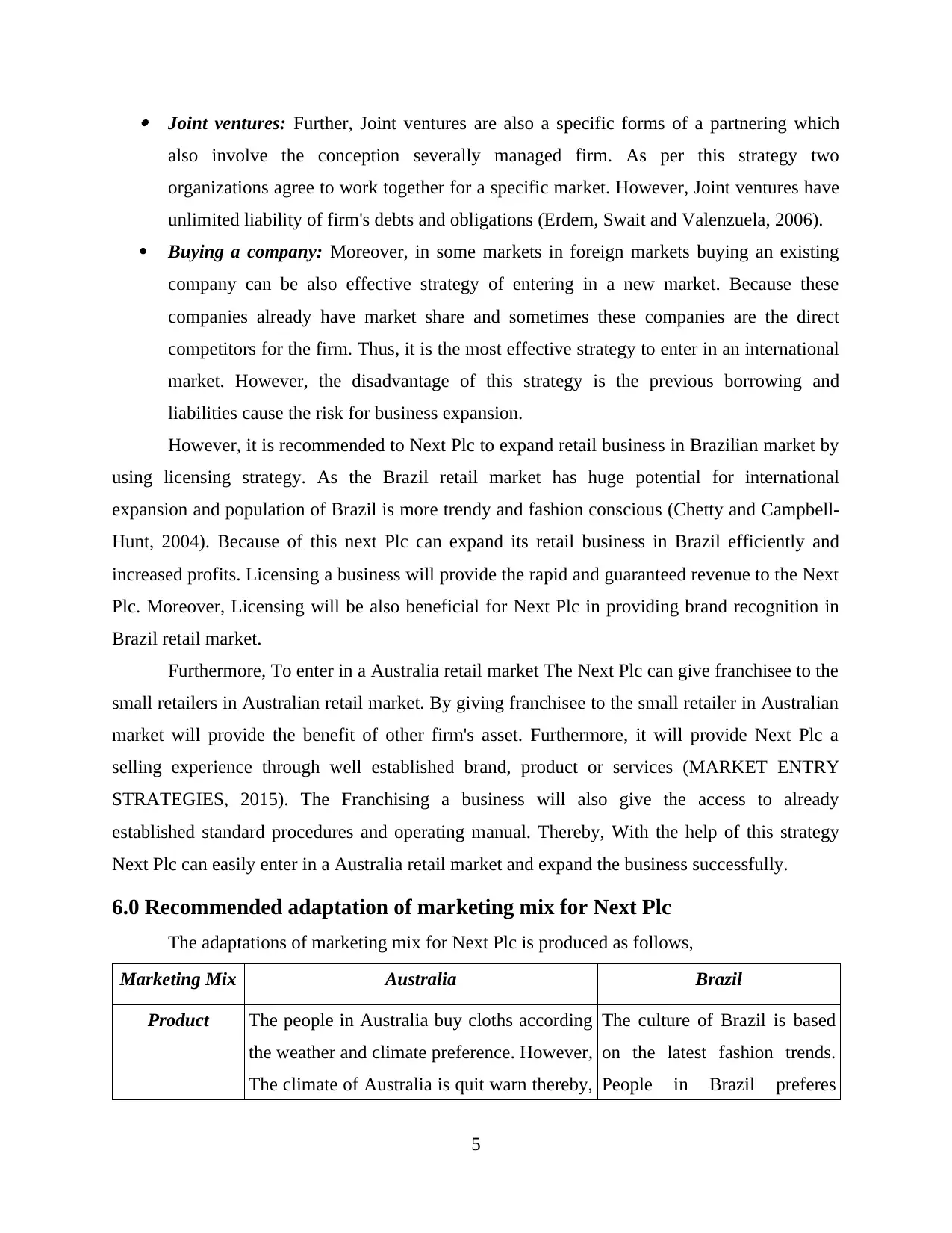
Joint ventures: Further, Joint ventures are also a specific forms of a partnering which
also involve the conception severally managed firm. As per this strategy two
organizations agree to work together for a specific market. However, Joint ventures have
unlimited liability of firm's debts and obligations (Erdem, Swait and Valenzuela, 2006).
Buying a company: Moreover, in some markets in foreign markets buying an existing
company can be also effective strategy of entering in a new market. Because these
companies already have market share and sometimes these companies are the direct
competitors for the firm. Thus, it is the most effective strategy to enter in an international
market. However, the disadvantage of this strategy is the previous borrowing and
liabilities cause the risk for business expansion.
However, it is recommended to Next Plc to expand retail business in Brazilian market by
using licensing strategy. As the Brazil retail market has huge potential for international
expansion and population of Brazil is more trendy and fashion conscious (Chetty and Campbell-
Hunt, 2004). Because of this next Plc can expand its retail business in Brazil efficiently and
increased profits. Licensing a business will provide the rapid and guaranteed revenue to the Next
Plc. Moreover, Licensing will be also beneficial for Next Plc in providing brand recognition in
Brazil retail market.
Furthermore, To enter in a Australia retail market The Next Plc can give franchisee to the
small retailers in Australian retail market. By giving franchisee to the small retailer in Australian
market will provide the benefit of other firm's asset. Furthermore, it will provide Next Plc a
selling experience through well established brand, product or services (MARKET ENTRY
STRATEGIES, 2015). The Franchising a business will also give the access to already
established standard procedures and operating manual. Thereby, With the help of this strategy
Next Plc can easily enter in a Australia retail market and expand the business successfully.
6.0 Recommended adaptation of marketing mix for Next Plc
The adaptations of marketing mix for Next Plc is produced as follows,
Marketing Mix Australia Brazil
Product The people in Australia buy cloths according
the weather and climate preference. However,
The climate of Australia is quit warn thereby,
The culture of Brazil is based
on the latest fashion trends.
People in Brazil preferes
5
also involve the conception severally managed firm. As per this strategy two
organizations agree to work together for a specific market. However, Joint ventures have
unlimited liability of firm's debts and obligations (Erdem, Swait and Valenzuela, 2006).
Buying a company: Moreover, in some markets in foreign markets buying an existing
company can be also effective strategy of entering in a new market. Because these
companies already have market share and sometimes these companies are the direct
competitors for the firm. Thus, it is the most effective strategy to enter in an international
market. However, the disadvantage of this strategy is the previous borrowing and
liabilities cause the risk for business expansion.
However, it is recommended to Next Plc to expand retail business in Brazilian market by
using licensing strategy. As the Brazil retail market has huge potential for international
expansion and population of Brazil is more trendy and fashion conscious (Chetty and Campbell-
Hunt, 2004). Because of this next Plc can expand its retail business in Brazil efficiently and
increased profits. Licensing a business will provide the rapid and guaranteed revenue to the Next
Plc. Moreover, Licensing will be also beneficial for Next Plc in providing brand recognition in
Brazil retail market.
Furthermore, To enter in a Australia retail market The Next Plc can give franchisee to the
small retailers in Australian retail market. By giving franchisee to the small retailer in Australian
market will provide the benefit of other firm's asset. Furthermore, it will provide Next Plc a
selling experience through well established brand, product or services (MARKET ENTRY
STRATEGIES, 2015). The Franchising a business will also give the access to already
established standard procedures and operating manual. Thereby, With the help of this strategy
Next Plc can easily enter in a Australia retail market and expand the business successfully.
6.0 Recommended adaptation of marketing mix for Next Plc
The adaptations of marketing mix for Next Plc is produced as follows,
Marketing Mix Australia Brazil
Product The people in Australia buy cloths according
the weather and climate preference. However,
The climate of Australia is quit warn thereby,
The culture of Brazil is based
on the latest fashion trends.
People in Brazil preferes
5
Paraphrase This Document
Need a fresh take? Get an instant paraphrase of this document with our AI Paraphraser
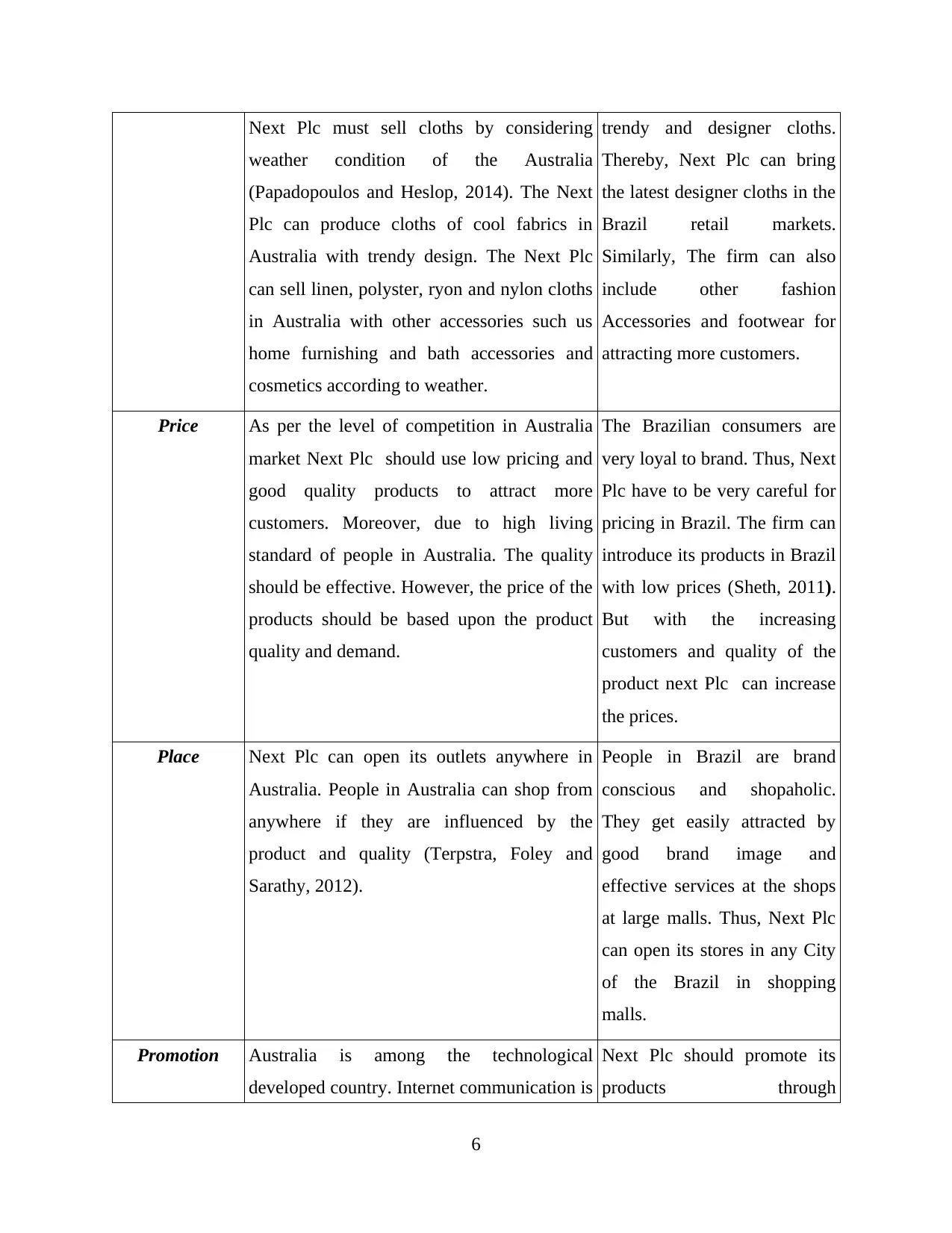
Next Plc must sell cloths by considering
weather condition of the Australia
(Papadopoulos and Heslop, 2014). The Next
Plc can produce cloths of cool fabrics in
Australia with trendy design. The Next Plc
can sell linen, polyster, ryon and nylon cloths
in Australia with other accessories such us
home furnishing and bath accessories and
cosmetics according to weather.
trendy and designer cloths.
Thereby, Next Plc can bring
the latest designer cloths in the
Brazil retail markets.
Similarly, The firm can also
include other fashion
Accessories and footwear for
attracting more customers.
Price As per the level of competition in Australia
market Next Plc should use low pricing and
good quality products to attract more
customers. Moreover, due to high living
standard of people in Australia. The quality
should be effective. However, the price of the
products should be based upon the product
quality and demand.
The Brazilian consumers are
very loyal to brand. Thus, Next
Plc have to be very careful for
pricing in Brazil. The firm can
introduce its products in Brazil
with low prices (Sheth, 2011).
But with the increasing
customers and quality of the
product next Plc can increase
the prices.
Place Next Plc can open its outlets anywhere in
Australia. People in Australia can shop from
anywhere if they are influenced by the
product and quality (Terpstra, Foley and
Sarathy, 2012).
People in Brazil are brand
conscious and shopaholic.
They get easily attracted by
good brand image and
effective services at the shops
at large malls. Thus, Next Plc
can open its stores in any City
of the Brazil in shopping
malls.
Promotion Australia is among the technological
developed country. Internet communication is
Next Plc should promote its
products through
6
weather condition of the Australia
(Papadopoulos and Heslop, 2014). The Next
Plc can produce cloths of cool fabrics in
Australia with trendy design. The Next Plc
can sell linen, polyster, ryon and nylon cloths
in Australia with other accessories such us
home furnishing and bath accessories and
cosmetics according to weather.
trendy and designer cloths.
Thereby, Next Plc can bring
the latest designer cloths in the
Brazil retail markets.
Similarly, The firm can also
include other fashion
Accessories and footwear for
attracting more customers.
Price As per the level of competition in Australia
market Next Plc should use low pricing and
good quality products to attract more
customers. Moreover, due to high living
standard of people in Australia. The quality
should be effective. However, the price of the
products should be based upon the product
quality and demand.
The Brazilian consumers are
very loyal to brand. Thus, Next
Plc have to be very careful for
pricing in Brazil. The firm can
introduce its products in Brazil
with low prices (Sheth, 2011).
But with the increasing
customers and quality of the
product next Plc can increase
the prices.
Place Next Plc can open its outlets anywhere in
Australia. People in Australia can shop from
anywhere if they are influenced by the
product and quality (Terpstra, Foley and
Sarathy, 2012).
People in Brazil are brand
conscious and shopaholic.
They get easily attracted by
good brand image and
effective services at the shops
at large malls. Thus, Next Plc
can open its stores in any City
of the Brazil in shopping
malls.
Promotion Australia is among the technological
developed country. Internet communication is
Next Plc should promote its
products through
6
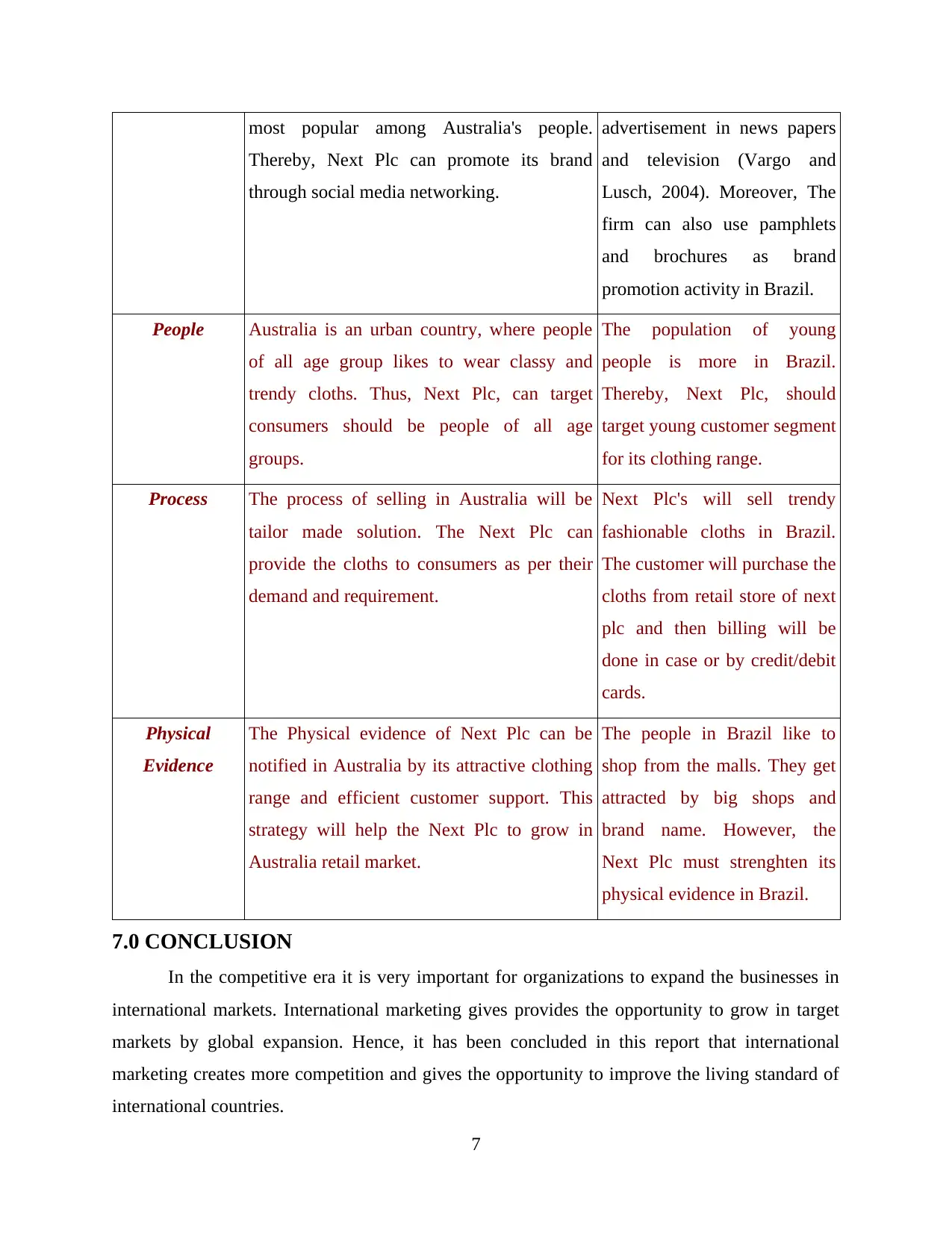
most popular among Australia's people.
Thereby, Next Plc can promote its brand
through social media networking.
advertisement in news papers
and television (Vargo and
Lusch, 2004). Moreover, The
firm can also use pamphlets
and brochures as brand
promotion activity in Brazil.
People Australia is an urban country, where people
of all age group likes to wear classy and
trendy cloths. Thus, Next Plc, can target
consumers should be people of all age
groups.
The population of young
people is more in Brazil.
Thereby, Next Plc, should
target young customer segment
for its clothing range.
Process The process of selling in Australia will be
tailor made solution. The Next Plc can
provide the cloths to consumers as per their
demand and requirement.
Next Plc's will sell trendy
fashionable cloths in Brazil.
The customer will purchase the
cloths from retail store of next
plc and then billing will be
done in case or by credit/debit
cards.
Physical
Evidence
The Physical evidence of Next Plc can be
notified in Australia by its attractive clothing
range and efficient customer support. This
strategy will help the Next Plc to grow in
Australia retail market.
The people in Brazil like to
shop from the malls. They get
attracted by big shops and
brand name. However, the
Next Plc must strenghten its
physical evidence in Brazil.
7.0 CONCLUSION
In the competitive era it is very important for organizations to expand the businesses in
international markets. International marketing gives provides the opportunity to grow in target
markets by global expansion. Hence, it has been concluded in this report that international
marketing creates more competition and gives the opportunity to improve the living standard of
international countries.
7
Thereby, Next Plc can promote its brand
through social media networking.
advertisement in news papers
and television (Vargo and
Lusch, 2004). Moreover, The
firm can also use pamphlets
and brochures as brand
promotion activity in Brazil.
People Australia is an urban country, where people
of all age group likes to wear classy and
trendy cloths. Thus, Next Plc, can target
consumers should be people of all age
groups.
The population of young
people is more in Brazil.
Thereby, Next Plc, should
target young customer segment
for its clothing range.
Process The process of selling in Australia will be
tailor made solution. The Next Plc can
provide the cloths to consumers as per their
demand and requirement.
Next Plc's will sell trendy
fashionable cloths in Brazil.
The customer will purchase the
cloths from retail store of next
plc and then billing will be
done in case or by credit/debit
cards.
Physical
Evidence
The Physical evidence of Next Plc can be
notified in Australia by its attractive clothing
range and efficient customer support. This
strategy will help the Next Plc to grow in
Australia retail market.
The people in Brazil like to
shop from the malls. They get
attracted by big shops and
brand name. However, the
Next Plc must strenghten its
physical evidence in Brazil.
7.0 CONCLUSION
In the competitive era it is very important for organizations to expand the businesses in
international markets. International marketing gives provides the opportunity to grow in target
markets by global expansion. Hence, it has been concluded in this report that international
marketing creates more competition and gives the opportunity to improve the living standard of
international countries.
7
⊘ This is a preview!⊘
Do you want full access?
Subscribe today to unlock all pages.

Trusted by 1+ million students worldwide

8
Paraphrase This Document
Need a fresh take? Get an instant paraphrase of this document with our AI Paraphraser
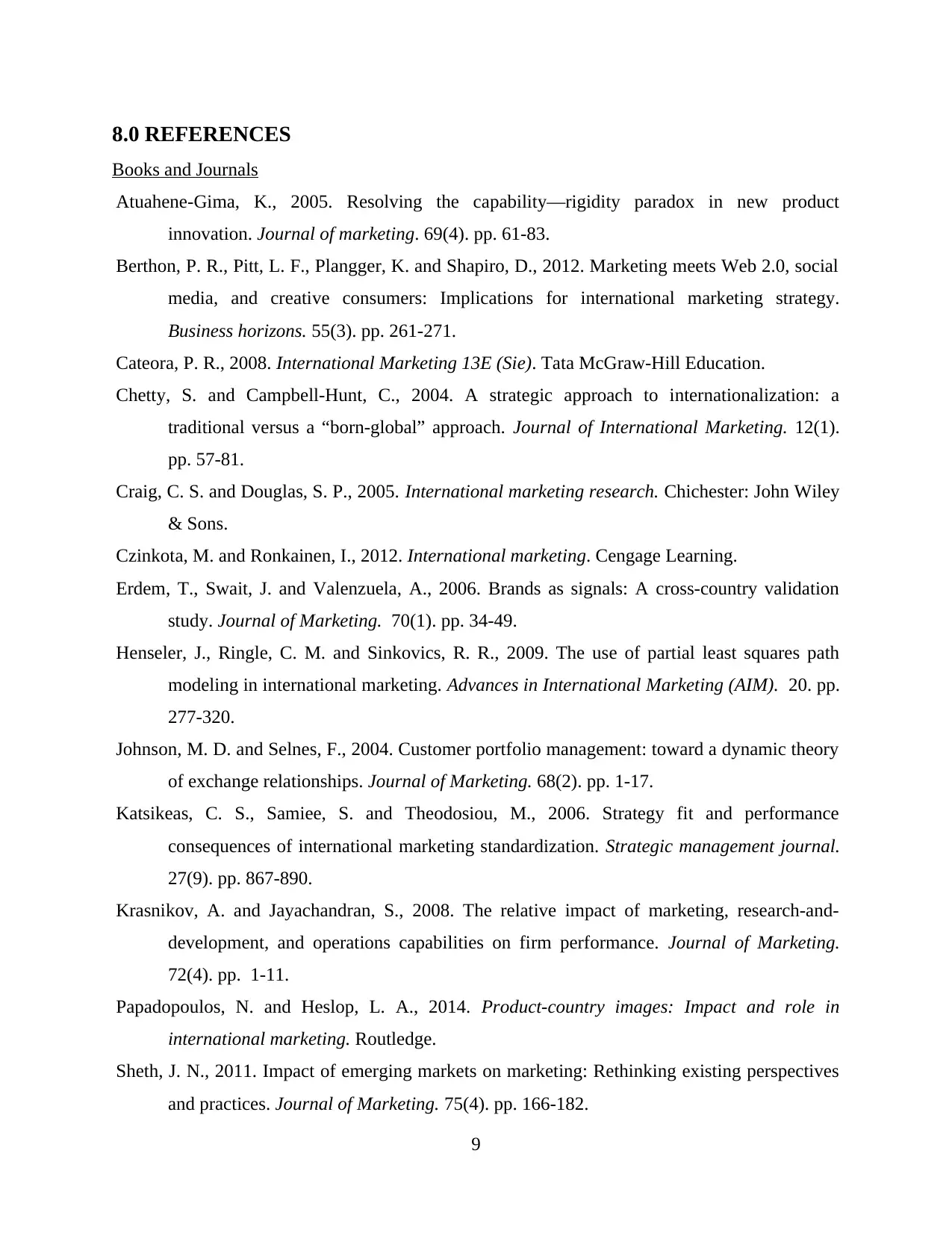
8.0 REFERENCES
Books and Journals
Atuahene-Gima, K., 2005. Resolving the capability—rigidity paradox in new product
innovation. Journal of marketing. 69(4). pp. 61-83.
Berthon, P. R., Pitt, L. F., Plangger, K. and Shapiro, D., 2012. Marketing meets Web 2.0, social
media, and creative consumers: Implications for international marketing strategy.
Business horizons. 55(3). pp. 261-271.
Cateora, P. R., 2008. International Marketing 13E (Sie). Tata McGraw-Hill Education.
Chetty, S. and Campbell-Hunt, C., 2004. A strategic approach to internationalization: a
traditional versus a “born-global” approach. Journal of International Marketing. 12(1).
pp. 57-81.
Craig, C. S. and Douglas, S. P., 2005. International marketing research. Chichester: John Wiley
& Sons.
Czinkota, M. and Ronkainen, I., 2012. International marketing. Cengage Learning.
Erdem, T., Swait, J. and Valenzuela, A., 2006. Brands as signals: A cross-country validation
study. Journal of Marketing. 70(1). pp. 34-49.
Henseler, J., Ringle, C. M. and Sinkovics, R. R., 2009. The use of partial least squares path
modeling in international marketing. Advances in International Marketing (AIM). 20. pp.
277-320.
Johnson, M. D. and Selnes, F., 2004. Customer portfolio management: toward a dynamic theory
of exchange relationships. Journal of Marketing. 68(2). pp. 1-17.
Katsikeas, C. S., Samiee, S. and Theodosiou, M., 2006. Strategy fit and performance
consequences of international marketing standardization. Strategic management journal.
27(9). pp. 867-890.
Krasnikov, A. and Jayachandran, S., 2008. The relative impact of marketing, research-and-
development, and operations capabilities on firm performance. Journal of Marketing.
72(4). pp. 1-11.
Papadopoulos, N. and Heslop, L. A., 2014. Product-country images: Impact and role in
international marketing. Routledge.
Sheth, J. N., 2011. Impact of emerging markets on marketing: Rethinking existing perspectives
and practices. Journal of Marketing. 75(4). pp. 166-182.
9
Books and Journals
Atuahene-Gima, K., 2005. Resolving the capability—rigidity paradox in new product
innovation. Journal of marketing. 69(4). pp. 61-83.
Berthon, P. R., Pitt, L. F., Plangger, K. and Shapiro, D., 2012. Marketing meets Web 2.0, social
media, and creative consumers: Implications for international marketing strategy.
Business horizons. 55(3). pp. 261-271.
Cateora, P. R., 2008. International Marketing 13E (Sie). Tata McGraw-Hill Education.
Chetty, S. and Campbell-Hunt, C., 2004. A strategic approach to internationalization: a
traditional versus a “born-global” approach. Journal of International Marketing. 12(1).
pp. 57-81.
Craig, C. S. and Douglas, S. P., 2005. International marketing research. Chichester: John Wiley
& Sons.
Czinkota, M. and Ronkainen, I., 2012. International marketing. Cengage Learning.
Erdem, T., Swait, J. and Valenzuela, A., 2006. Brands as signals: A cross-country validation
study. Journal of Marketing. 70(1). pp. 34-49.
Henseler, J., Ringle, C. M. and Sinkovics, R. R., 2009. The use of partial least squares path
modeling in international marketing. Advances in International Marketing (AIM). 20. pp.
277-320.
Johnson, M. D. and Selnes, F., 2004. Customer portfolio management: toward a dynamic theory
of exchange relationships. Journal of Marketing. 68(2). pp. 1-17.
Katsikeas, C. S., Samiee, S. and Theodosiou, M., 2006. Strategy fit and performance
consequences of international marketing standardization. Strategic management journal.
27(9). pp. 867-890.
Krasnikov, A. and Jayachandran, S., 2008. The relative impact of marketing, research-and-
development, and operations capabilities on firm performance. Journal of Marketing.
72(4). pp. 1-11.
Papadopoulos, N. and Heslop, L. A., 2014. Product-country images: Impact and role in
international marketing. Routledge.
Sheth, J. N., 2011. Impact of emerging markets on marketing: Rethinking existing perspectives
and practices. Journal of Marketing. 75(4). pp. 166-182.
9
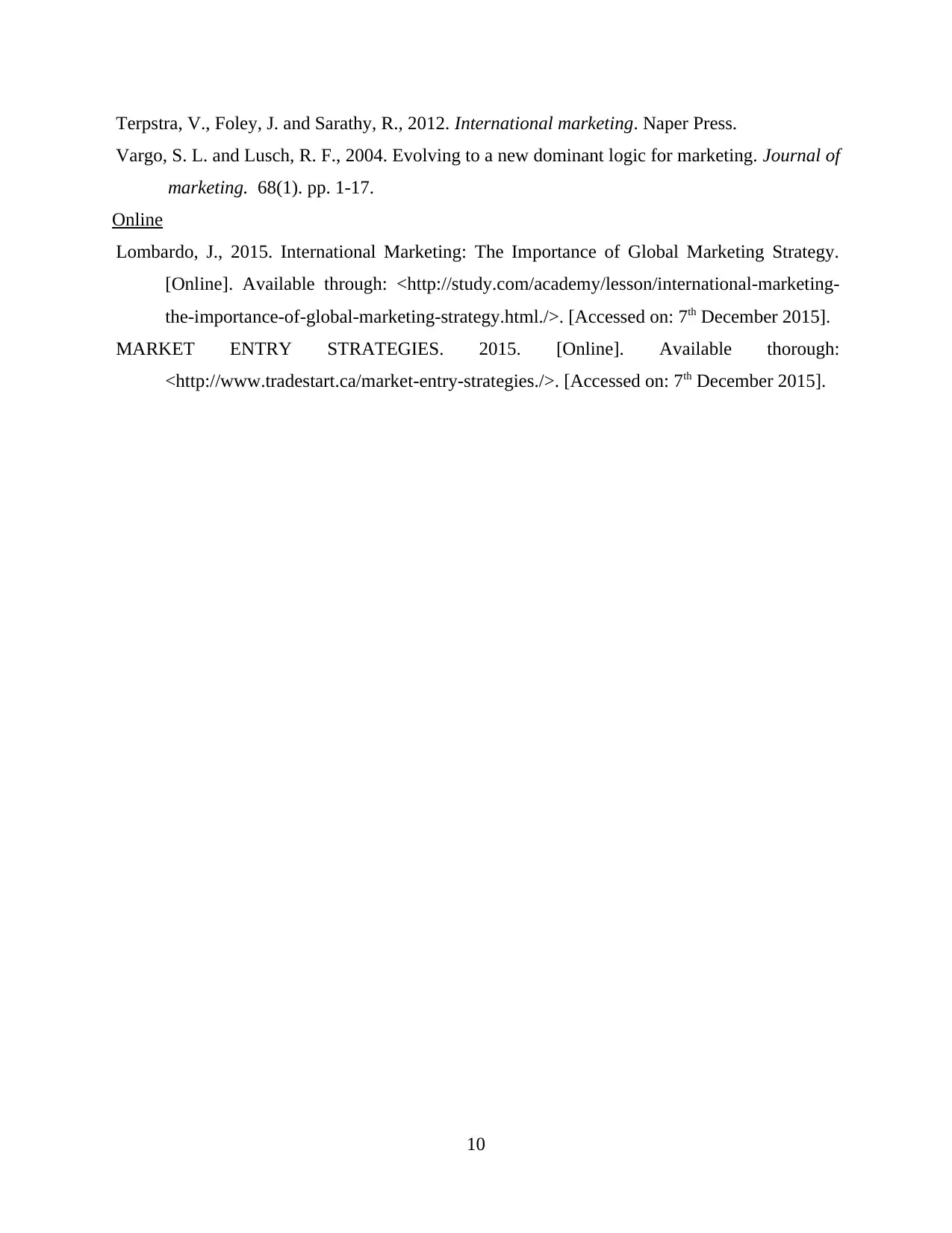
Terpstra, V., Foley, J. and Sarathy, R., 2012. International marketing. Naper Press.
Vargo, S. L. and Lusch, R. F., 2004. Evolving to a new dominant logic for marketing. Journal of
marketing. 68(1). pp. 1-17.
Online
Lombardo, J., 2015. International Marketing: The Importance of Global Marketing Strategy.
[Online]. Available through: <http://study.com/academy/lesson/international-marketing-
the-importance-of-global-marketing-strategy.html./>. [Accessed on: 7th December 2015].
MARKET ENTRY STRATEGIES. 2015. [Online]. Available thorough:
<http://www.tradestart.ca/market-entry-strategies./>. [Accessed on: 7th December 2015].
10
Vargo, S. L. and Lusch, R. F., 2004. Evolving to a new dominant logic for marketing. Journal of
marketing. 68(1). pp. 1-17.
Online
Lombardo, J., 2015. International Marketing: The Importance of Global Marketing Strategy.
[Online]. Available through: <http://study.com/academy/lesson/international-marketing-
the-importance-of-global-marketing-strategy.html./>. [Accessed on: 7th December 2015].
MARKET ENTRY STRATEGIES. 2015. [Online]. Available thorough:
<http://www.tradestart.ca/market-entry-strategies./>. [Accessed on: 7th December 2015].
10
⊘ This is a preview!⊘
Do you want full access?
Subscribe today to unlock all pages.

Trusted by 1+ million students worldwide
1 out of 14
Related Documents
Your All-in-One AI-Powered Toolkit for Academic Success.
+13062052269
info@desklib.com
Available 24*7 on WhatsApp / Email
![[object Object]](/_next/static/media/star-bottom.7253800d.svg)
Unlock your academic potential
Copyright © 2020–2025 A2Z Services. All Rights Reserved. Developed and managed by ZUCOL.





